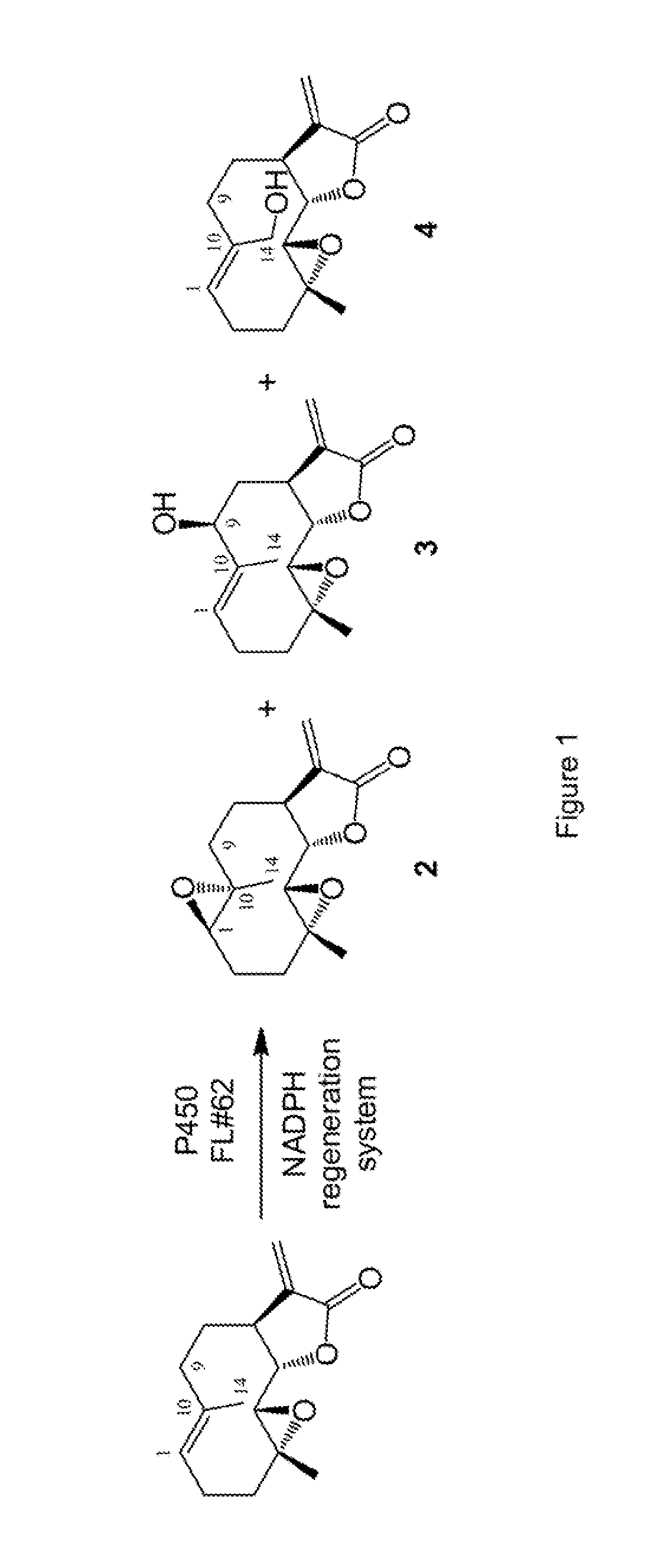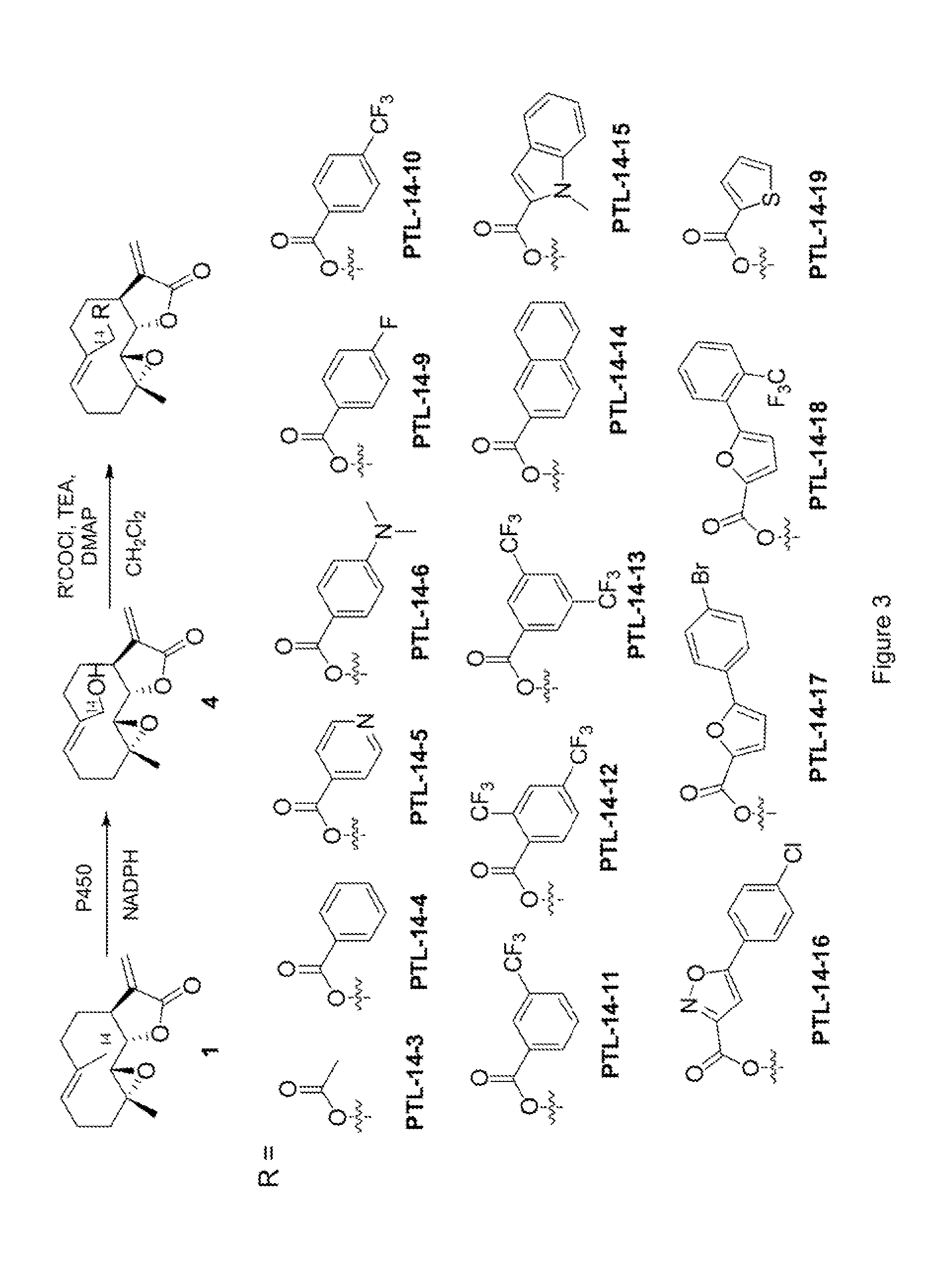Parthenolide derivatives, methods for their preparation and their use as anticancer agents
- Summary
- Abstract
- Description
- Claims
- Application Information
AI Technical Summary
Benefits of technology
Problems solved by technology
Method used
Image
Examples
example 1
6.1 Example 1
Isolation of Engineered P450 Polypeptides for Parthenolide Hydroxylation
[0228]In initial studies, we discovered that CYP102A1 variant FL#62 (SEQ ID NO: 12) is capable of efficiently oxidizing PTL, supporting more than 1,000 total turnovers (TTN) and producing a mixture of 1,10-epoxy-PTL (compound 2), 9(S)-hydroxy-PTL (compound 3), 14-hydroxy-PTL (compound 4) in 77:13:10 ratio (FIG. 1 and Table 1). The hydroxylation products 3 and 4 were of particular interest, as they can provide two valuable intermediates, not accessible via currently available synthetic methods, for re-elaboration of parthenolide carbocyclic skeleton by chemoenzymatic means. A collection of about 500 FL#62-derived P450s were obtained via a two step process involving (a) simultaneous site-saturation mutagenesis of multiple ‘first-sphere’ active-site residues (i.e. 74, 78, 81, 82, 87, 181, and 184), followed by (b) high-throughput mapping of the active site configuration of the resulting engineered P450...
example 2
6.2 Example 2
Synthesis of 9-hydroxy-parthenolide and 14-hydroxy-parthenolide Using Purified Enzyme
[0231]This example demonstrates how engineered P450 polypeptides provided herein are useful for enabling the synthesis of the derivative 9-hydroxy-parthenolide and 14-hydroxy-parthenolide at preparative scales.
[0232]General Conditions for Enzymatic Reactions:
[0233]To phosphate buffer (50 mM, pH 8.0) was added P450 (2 μM), parthenolide (1 mM), NADP+ (150 μM), PTDH (2 μM), and sodium phosphite (50 mM, pH 8.0). After stirring for 12 hours at room temperature, the reactions were extracted with dichloromethane (3×30 mL) and separated via centrifugation. The combined organic layers were dried over sodium sulfate, concentrated under reduced pressure, and purified by silica gel flash chromatography (10 to 60% ethyl acetate in hexanes).
[0234]To prepare 9(S)-hydroxy-parthenolide (3), purified P450 variant XII-F12 (SEQ ID NO: 19) (final conc: 2.5 μM; 0.26 mol %) was dissolved in 400 mL 50 mM phosp...
example 3
6.3 Example 3
Synthesis of 9-hydroxy-parthenolide and 14-hydroxy-parthenolide Using Whole-Cell Systems
[0236]This example demonstrates how whole-cell systems containing engineered P450 polypeptides provided herein, are useful for enabling the synthesis of the derivative 9-hydroxy-parthenolide and 14-hydroxy-parthenolide at preparative scales.
[0237]General Conditions for Whole-Cell Reactions:
[0238]E. coli cells (DH5α) were transformed with a pCWori-based plasmid encoding for the desired P450 under IPTG inducible promoter and a second, pAcyc-based plasmid encoding for the phosphite dehydrogenase (PTDH) enzyme under an arabinose-inducible promoter. Cells were grown in TB medium containing ampicillin (50 mg / L) and chloramphenicol (34 mg / L) until OD600 reached 1.0. The cells were then induced with IPTG (0.2 mM) and arabinose (0.1%) and harvested after 24 hours. Cells were then resuspended in phosphate buffer and permeabilized via two cycles of freezing / thawing. Parthenolide (100 mg) and ph...
PUM
| Property | Measurement | Unit |
|---|---|---|
| Fraction | aaaaa | aaaaa |
| Fraction | aaaaa | aaaaa |
| Electrical conductance | aaaaa | aaaaa |
Abstract
Description
Claims
Application Information
 Login to View More
Login to View More - R&D
- Intellectual Property
- Life Sciences
- Materials
- Tech Scout
- Unparalleled Data Quality
- Higher Quality Content
- 60% Fewer Hallucinations
Browse by: Latest US Patents, China's latest patents, Technical Efficacy Thesaurus, Application Domain, Technology Topic, Popular Technical Reports.
© 2025 PatSnap. All rights reserved.Legal|Privacy policy|Modern Slavery Act Transparency Statement|Sitemap|About US| Contact US: help@patsnap.com



